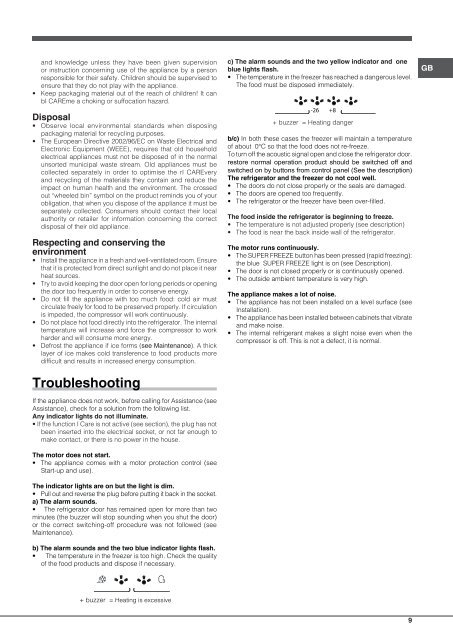KitchenAid XAO95 T2U GOH - Fridge/freezer combination - XAO95 T2U GOH - Fridge/freezer combination EN (F088562) Istruzioni per l'Uso
KitchenAid XAO95 T2U GOH - Fridge/freezer combination - XAO95 T2U GOH - Fridge/freezer combination EN (F088562) Istruzioni per l'Uso
KitchenAid XAO95 T2U GOH - Fridge/freezer combination - XAO95 T2U GOH - Fridge/freezer combination EN (F088562) Istruzioni per l'Uso
You also want an ePaper? Increase the reach of your titles
YUMPU automatically turns print PDFs into web optimized ePapers that Google loves.
and knowledge unless they have been given su<strong>per</strong>vision<br />
or instruction concerning use of the appliance by a <strong>per</strong>son<br />
responsible for their safety. Children should be su<strong>per</strong>vised to<br />
ensure that they do not play with the appliance.<br />
• Keep packaging material out of the reach of children! It can<br />
bI CAREme a choking or suffocation hazard.<br />
Disposal<br />
• Observe local environmental standards when disposing<br />
packaging material for recycling purposes.<br />
• The European Directive 2002/96/EC on Waste Electrical and<br />
Electronic Equipment (WEEE), requires that old household<br />
electrical appliances must not be disposed of in the normal<br />
unsorted municipal waste stream. Old appliances must be<br />
collected separately in order to optimise the rI CAREvery<br />
and recycling of the materials they contain and reduce the<br />
impact on human health and the environment. The crossed<br />
out “wheeled bin” symbol on the product reminds you of your<br />
obligation, that when you dispose of the appliance it must be<br />
separately collected. Consumers should contact their local<br />
authority or retailer for information concerning the correct<br />
disposal of their old appliance.<br />
Respecting and conserving the<br />
environment<br />
• Install the appliance in a fresh and well-ventilated room. Ensure<br />
that it is protected from direct sunlight and do not place it near<br />
heat sources.<br />
• Try to avoid keeping the door open for long <strong>per</strong>iods or opening<br />
the door too frequently in order to conserve energy.<br />
• Do not fill the appliance with too much food: cold air must<br />
circulate freely for food to be preserved pro<strong>per</strong>ly. If circulation<br />
is impeded, the compressor will work continuously.<br />
• Do not place hot food directly into the refrigerator. The internal<br />
tem<strong>per</strong>ature will increase and force the compressor to work<br />
harder and will consume more energy.<br />
• Defrost the appliance if ice forms (see Maintenance). A thick<br />
layer of ice makes cold transference to food products more<br />
difficult and results in increased energy consumption.<br />
Troubleshooting<br />
If the appliance does not work, before calling for Assistance (see<br />
Assistance), check for a solution from the following list.<br />
Any indicator lights do not illuminate.<br />
• If the function I Care is not active (see section), the plug has not<br />
been inserted into the electrical socket, or not far enough to<br />
make contact, or there is no power in the house.<br />
The motor does not start.<br />
• The appliance comes with a motor protection control (see<br />
Start-up and use).<br />
The indicator lights are on but the light is dim.<br />
• Pull out and reverse the plug before putting it back in the socket.<br />
a) The alarm sounds.<br />
• The refrigerator door has remained open for more than two<br />
minutes (the buzzer will stop sounding when you shut the door)<br />
or the correct switching-off procedure was not followed (see<br />
Maintenance).<br />
b) The alarm sounds and the two blue indicator lights flash.<br />
• The tem<strong>per</strong>ature in the <strong>freezer</strong> is too high. Check the quality<br />
of the food products and dispose if necessary.<br />
c) The alarm sounds and the two yellow indicator and one<br />
blue lights flash.<br />
• The tem<strong>per</strong>ature in the <strong>freezer</strong> has reached a dangerous level.<br />
The food must be disposed immediately.<br />
-26 +8<br />
+ buzzer = Heating danger<br />
b/c) In both these cases the <strong>freezer</strong> will maintain a tem<strong>per</strong>ature<br />
of about 0°C so that the food does not re-freeze.<br />
To turn off the acoustic signal open and close the refrigerator door.<br />
restore normal o<strong>per</strong>ation product should be switched off and<br />
switched on by buttons from control panel (See the description)<br />
The refrigerator and the <strong>freezer</strong> do not cool well.<br />
• The doors do not close pro<strong>per</strong>ly or the seals are damaged.<br />
• The doors are opened too frequently.<br />
• The refrigerator or the <strong>freezer</strong> have been over-filled.<br />
The food inside the refrigerator is beginning to freeze.<br />
• The tem<strong>per</strong>ature is not adjusted pro<strong>per</strong>ly (see description)<br />
• The food is near the back inside wall of the refrigerator.<br />
The motor runs continuously.<br />
• The SUPER FREEZE button has been pressed (rapid freezing):<br />
the blue SUPER FREEZE light is on (see Description).<br />
• The door is not closed pro<strong>per</strong>ly or is continuously opened.<br />
• The outside ambient tem<strong>per</strong>ature is very high.<br />
The appliance makes a lot of noise.<br />
• The appliance has not been installed on a level surface (see<br />
Installation).<br />
• The appliance has been installed between cabinets that vibrate<br />
and make noise.<br />
• The internal refrigerant makes a slight noise even when the<br />
compressor is off. This is not a defect, it is normal.<br />
GB<br />
+ buzzer = Heating is excessive<br />
9
















